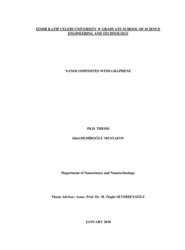Nanocomposites with graphene
- Tez Danışmanı M. Özgür SEYDİBEYOĞLU
-
Tür
Doktora Tezi
- Yayın Tarihi 2018
-
Yayıncı
İzmir Katip Çelebi Üniversitesi Fen Bilimleri Enstitüsü
- Tek Biçim Adres Http://hdl.handle.net/11469/370
The carbon fiber used in the manufacturing of advanced composites has various applications in the automotive, aerospace, and electronics industry because of their comprehensive properties such as lightweight, flexibility, high strength to weight ratio, excellent chemical resistance, superior electrical conductivity and thermal conductivity.
Different kinds of carbon fiber precursors have been used and polyacrylonitrile (PAN) is the mostly utilized polymer type which is a petroleum-based, expensive and unsustainable. Remarkably, lignin is a highly accessible, low-cost, and renewable resource. Also, lignin is a byproduct of pulp and paper industry as well as cellulosic ethanol fuel production. So, the reuse of this byproduct is very significant for the bioeconomy. Accordingly, understanding the structure, types, and extraction methods of lignin are of great importance for transferring these biomass residues from a low-value material to a higher value product.
This work started with the extracted lignin from Turkish resources (Turkish Pine and Turkish Vine stem) by sulfuric acid treatment and to compare with commercial lignin. Additionally, we investigated lignin to identify its suitability as a carbon fiber precursor and to use for reducing the processing cost of carbon fiber production compared to other precursors.
In this thesis, sub-micron lignin-based nanofibers were produced by electrospinning of solutions obtained by dispersing lignin, polyacrylonitrile (PAN) and then graphene (GRP) in N, N-dimethylformamide (DMF). Lignin-based carbon nanofibers were investigated by focusing on the steps of manufacture. Resource types and corresponding pretreatments improve the processability of spinning and thermal treatments. Defect-free nanofibers with up to 5 wt. % lignin/PAN and 1% graphene were fabricated successfully. The succeeding step is the most significant process of stabilization, where nanofibers are oxidized, crosslinked, and thermally stabilized for the following step. After carbonization, lignin-based carbon nanofibers are obtained. When carbonized at 900 °C, PAN/Lignin/GRP carbon nanofiber presents carbon content of 94.3% and with average diameter ~ 100 nm. Effects of every single step on the lignin-based carbon nanofibers have been discussed comprehensively.
To sum up, the low cost of carbon nanofibers and graphene reinforced carbon nanofibers can be used in numerous fields, mainly for electronic devices containing biosensors and supercapacitors. In this thesis, the characterization of carbon nanofiber (CNF) and graphene reinforced carbon nanofiber (CNF-G) modification onto the screen printed electrode (SPE) has been verified via Electrochemical Impedance Spectroscopy (EIS) and Cyclic Voltammetry (CV). The charge transfer resistance, Rct values obtained by electrochemical circle fit option of EIS have been utilized for conductivity detection of modified electrodes. In the last part of this thesis, CNF and CNF-G modified electrodes were performed for an effective biosensor to detect acetaminophen.
-
Koleksiyonlar
ENSTİTÜLER
FEN BİLİMLERİ ENSTİTÜSÜ

 Tam Metin
Tam Metin

